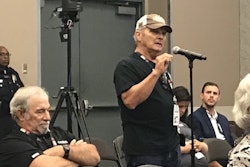
The FMCSA asked for comments to be submitted toward potentially revising the hours of service rules. I’ll be the umpteenth person to ask, Have you done it? Make your voice heard in a respectful, logical manner, and when it comes to the HOS rules, there are many who feel change must be made, of course. Still, how do we make an argument without having that argument dismissed due to the passion of the issue? First, we must logically look at the issue and remove passion from it. What is safe and what will work for everyone involved?
Finding balance is not an easy task, I know. What works for many may not work for all, simply because there are so many different segments within the industry. However, that is the task the FMCSA must tackle, and if we wish our comments to be heard, then we must attempt to do the same. Shouting, screaming and cursing do nothing more than express your limited vocabulary and nullify your arguments.
All that being said, here’s a link to the regulations.gov portal to express your ideas and comments concerning the hours of service rules. I know many drivers who are thoughtful, giving, and highly intelligent – a reality all of us can strive for and achieve, yet one that can be destroyed in a heartbeat with misguided passion and disrespectful commentary. As the old saying goes, you catch more flies with honey.
Below are my comments to the FMCSA on the hours subject, the comment period now open with the latest extension through October 10. These ideas may not be what everyone wants or likes, but they are hopefully thought-provoking. There are no rewards for whining and crying, only a $5 fine, as the old song goes.
 If you commented, what did you suggest for hours revision? If you’re reading on a smartphone, tap the image to call and weigh in with a message on our podcast line. If you’re on a desktop, call 530-408-6423. Make sure to tell us your name and state of residence.
If you commented, what did you suggest for hours revision? If you’re reading on a smartphone, tap the image to call and weigh in with a message on our podcast line. If you’re on a desktop, call 530-408-6423. Make sure to tell us your name and state of residence.First, I think allowing drivers to work more than 14 hours a day is pushing safety limits. However, that said, I think your best options are:
Drivers can only work 14 hours in a 24-hour period, which means if a driver starts their day a 5 a.m. they have until 5 a.m. the following day to complete the 14 hours and cannot get another 14 hours until they take a total 10-hour break, with a minimum of 8 hours in the sleeper.
Drivers should be allowed to split their break to help with congestion issues, or weather conditions, such as: If a driver starts the day and finds they are going to hit Atlanta during morning or evening rush hour, they should be able to stop, take a break allow traffic to thin out, and then continue their trip. Time used during that break should count towards their ten-hour break. However, when they finish their 11-hour driving period they must take at least 8 hours in the sleeper and it should state “in the sleeper.” Current HOS rules do not distinguish between sleeper and off duty, which means a driver could spend his entire time in a casino getting no sleep and drive after.
The 30-minute break is not necessary, if drivers are allowed to break when they need to due to traffic or weather conditions. All too often, I see drivers flying through construction zones, pushing in bad weather or not maintaining their lane because of drowsiness, which appears to have worsened since the ELD mandate came into play, coupled with the inability to stop the 14-hour clock. Of course, this is not scientific. Just simple observation.
Currently, we are the only industry in the world that I know of that works on an 8-day week due to the 70-hour rule. I believe it is time to get rid of the 70-hour rule, as it hinders day-to-day productivity when drivers are forced to sit at docks for hours on end. That said, while it is not exactly FMCSA’s charge to regulate shippers and receivers’ actions and efficiency, they can regulate what a driver should be paid for by determining that it would improve safety for drivers if drivers logged all hours (i.e. pre-trip, post-trip inspection time, and time spent sitting in shops and at docks loading and unloading). It has been forced upon drivers by some carriers to log shop time and dock time off duty to keep from burning up the clock. ELDs have brought that issue to light, and it would be a harm to drivers not to address that issue if revision of HOS should happen. At the same time, if drivers were paid for truck inspection time either at DOT stations, or at the beginning and ending of their shift, a more complete job might be done, helping prevent breakdowns on the side of the road, and improving the safety of vehicles. With the elimination of the 70-hour rule, it should be mandatory all drivers must take at least one 24-hour period off a week. Any time they choose to make the schedules work for deliveries or loading.
These revisions would relieve some of the stress drivers deal with every day while watching the clock tick away. They would also allow carriers more flexibility in scheduling, cut down on excessive fuel consumption from wasted time sitting in traffic, and perhaps reduce the number of traffic accidents, allowing drivers to sit out rush hour conditions. These changes would allow drivers to stop their 14-hour clock when necessary.
These revisions would also work for local drivers not keeping a logbook. However, I have worked local LTL and found it ten times more exhausting than over the road. Remember much of the LTL work done is the unloading of freight by hand, or by pallet jack. Many times, drivers are forced to break down pallets to avoid sitting and waiting at docks, because schedules do not allow time for that. Therefore, local LTL drivers within 150-mile air radius should be limited to 12-hour days.
Much of what I have stated is simply common-sense observations from 20 years more than 3,000,000 accident-free miles in the industry.










